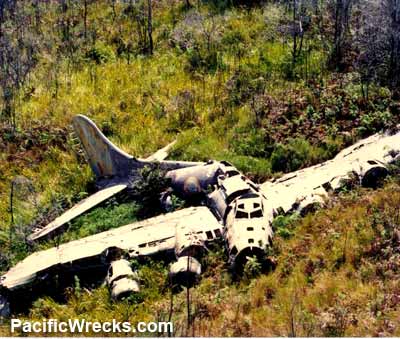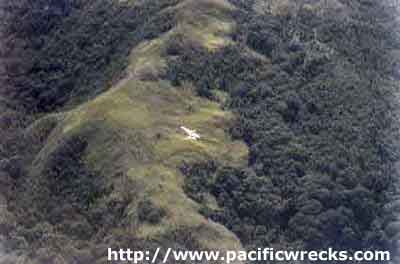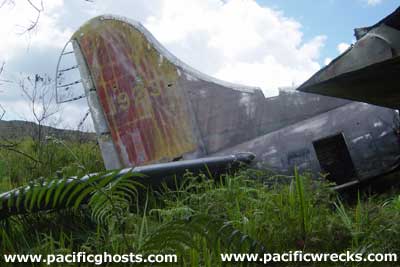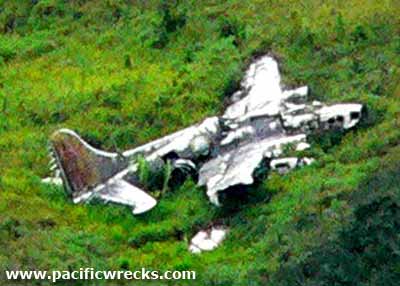|
|
| Missing In Action (MIA) | Prisoners Of War (POW) | Unexploded Ordnance (UXO) |
| Chronology | Locations | Aircraft | Ships | Submit Info | How You Can Help | Donate |
|
| USAAF 5th AF 43rd BG 65th BS Former Assignments 19th BG 28th BS 43rd BG c1942  Richard Leahy c1980   Phil Bradley 1996   Justin Taylan 2003  Scott Nicholls 2004  Phil Bradley 2005  Phil Bradley 2008 |
Pilot 1st Lt Raymond S. Dau, O-424250 (survived) Arlington, VA Co-Pilot 2nd Lt Donald W. Hoggan, O-661930 (survived) Puente, CA Bombardier 2nd Lt Albert V. "Bud" Cole, O-724135 (survived) Kent County, MI Navigator 2nd Lt Peter J. Hudec, O-728213 (survived) Coaldale, PA Radio Sgt Robert H. Albright, 19003448 (WIA, died of wounds January 14, 1943) OH Engineer SSgt Lloyd T. Dumond, 17014140 (survived) Dewitt, AR Gunner Sgt Francis E. Caldwell, 36172510 (survived) Goss Pointe, MI Gunner Sgt Henry J. Blasco, 31043494 (survived) New Britain, CT Tail Gunner Sgt. Henry B. Bowen, 19094672 (WIA / KIA, BR) Trenton, ND Force Landed January 8, 1943 MACR none Aircraft History Built by Boeing at Seattle under contract W-535 AC-15677 at a cost of $280,135.00. Constructors Number 2706. When completed, this was the 501st of 512 B-17E model. On May 26, 1942 delivered to the U.S. Army Air Force (USAAF) as B-17E Flying Fortress serial number 41-9234. On May 30, 1942 one of thirty-two B-17 Flying Fortresses allocated to the Royal Air Force (RAF) Coastal Command as part of US-UK lend-lease. Flown to the United Air Lines Cheyenne Modification Center in Cheyenne, Wyoming. Over nine weeks, modified to a Fortress IIA with an astrodome and ASV Mark II aerial arrays for anti-submarine patrols. Painted in the RAF Coastal Command color scheme with extra dark sea gray (temperate sea) upper surfaces and sky lower surfaces. The U.S. markings applied at the factory were over painted with RAF roundels on the fuselage and wings plus RAF serial number FL461 painted in black on the rear fuselage. The U.S. Army serial number "19234" was retained on the tail for the delivery flight to England. Sometime in early July 1942, four lend-lease B-17s were returned to the U.S. Army including B-17E 41-9196, B-17E 41-9235, B-17E 41-9244 and B-17E 41-9234. Still at Cheyenne Modification Center, all four B-17s were returned to U.S. Army specifications with the astrodome and ASV Mark II aerial arrays removed. This B-17 retained the RAF paint scheme with U.S. markings reapplied over the RAF roundels. On August 6, 1942 flown to Hamilton Field. During the middle of August 1942 as part of "Project X" bound for "Sumac" (Australia) and flown to Hickam Field then across the Pacific to Australia. Assigned to the 5th Air Force (5th AF), 19th Bombardment Group (19th BG), 28th Bombardment Squadron (28th BS) based at Mareeba Airfield. No known nose art or nickname. On August 25, 1942 took off from Mareeba Airfield piloted by Captain John Chiles with co-pilot Lt. James C. Dieffenderfer with bombardier Sgt. Earl W. Snyder on a mission led by Major Felix Hardison against Japanese warships reportedly inside Milne Bay. After taking off two hours late, the B-17s spotted an Australian convoy of three ships but due to low ceiling and approaching darkness they failed to spot any enemy vessels before landing at 7 Mile Drome then flew back to Mareeba Airfield. On August 26, 1942 one of eight B-17s that took off from Mareeba Airfield at 4:45am piloted by Captain John Chiles (93rd BS) with co-pilot Lt. Jim Dieffenderfer as one of eight B-17s on a bombing mission against a Japanese convoy off Milne Bay. The magneto on engine no. 1 was dead and during take off blew a spark plug on engine no. 2 but proceeded on the mission anyway. The weather inbound to the target was horrible with a ceiling of only 2,000' or less. Although the convoy had already unloaded, the B-17s attacked between 6:30am to 7:45am from below an overcast from an altitude of roughly 1,500' and experienced accurate anti-aircraft fire from the warships. A shell exploded above this B-17's nose wounding both crew members inside. Bombardier Sgt. Earl W. Snyder was hit in the head by shrapnel. Although mortally wounded, he managed to drop their four 500 pound bombs before expiring. Navigator 1st Lt. David Hirsch's left leg was nearly severed by shrapnel. Engineer Sgt Wathen Cody left the top turret to investigate and found Snyder dead and applied a tourniquet to Hirsch's leg then dragged him onto the flight deck. During the attack, B-17F 41-24354 sustained a direct hit from anti-aircraft fire and crashed near the convoy. On September 12, 1942 took off from Mareeba Airfield piloted by Major Elbert "Butch" Helton on a bombing mission against Buna Airfield. On October 23, 1942 at 4:30am took off from Mareeba Airfield piloted by 1st Lt. Schmid with co-pilot 1st Lt. Simmons, navigator 2nd Lt. Peeples, bombardier 1st Lt. Nossum and landed at 8:00am at 7 Mile Drome then took off again at 9:30am on a search mission for enemy shipping in the Solomon Sea searching the area spanning from Lat 10°50' S and 11° 40' S to Long 157° E to 153° E. The bomber was armed with four 500lbs demolition bombs. Weather was good and no sightings were made flying at 200' to 1,000'. Encountered bad weather then returned to base at 5:40pm. On October 24, 1942 at 8:40am took off from 7 Mile Drome with the same crew to search the same area then landed at 5:25pm. On October 25, 1942 at 8:10am took off from 7 Mile Drome with the same crew on a search mission for enemy shipping in the Solomon Sea from Lat 9° 20' to 10° 10' Long 157° to 153° and south then returned at 5:25pm. In early December 1942, assigned to the assigned to the 43rd Bombardment Group (43rd BG) "Ken's Men", 65th Bombardment Squadron (65th BS). No known nose art or nickname. On December 7, 1942 took off as one of ten B-17s fincluding four from 63rd S BS and six from 65th BS on a bombing mission against Japanese tranports off Gasmata. Attacking from 2,000' the bombers made individual bomb runs on the ships and were intercepted by Zeros. This B-17 sustained 75 bullet holes including damage to the main spar and hydraulic system. In total, this B-17 flew twelve bombing missions in New Guinea before force landing. Mission History On January 8, 1943 took off from 7 Mile Drome near Port Moresby piloted by 1st Lt Raymond S. Dau as one of seven B-17s on a bombing mission against a Japanese convoy in the Huon Gulf off Lae. Over the target, anti-aircraft guns opened fire and fighters intercepted. This B-17 was the second to bomb and was hit by anti-aircraft fire damaging two engines, the nose and wounding two crew members. The pilots could neither climb nor turn. Dau recalled, "We were headed up a small valley and couldn't get over the mountains. I knew it was just a matter of time, so I began looking for a soft place to set her down. We glided in on the side of a mountain at about 110 miles an hour, and as luck would have it, there were no trees - nothing but nice soft grass - so we slid along into a crash landing". The B-17 force landed on a hillside near Kaisinik below Black Cat Pass to the east of Wau. During the crash landing, the fuselage broke rear of the radio compartment and tail gunner Sgt. Henry B. Bowen was killed in the crash and radio operator Robert Albright severely injured. Rescue Papuan scouts and Australian Commando, R. A. Dunne were the first to reach the crash site. Australian Army soldiers carried the crew in litters to Wau Airfield. Loaded aboard a RAAF Hudson, they were flown back to Port Moresby. Wounded Albright was admitted to the hospital in Port Moresby. On January 14, 1943 he died of his wounds. Wreckage After the war, this wreck puzzled many as weathering effects wore away the US Army markings to reveal the original RAF roundels and serial number FL461. Some incorrectly speculated the wreck was a RAF plane on a secret mission. Postwar, many nicknames developed for this wreck including: "Gray Ghost", "B-17 at Black Cat Pass" or "Wau B-17". Today, the plane is one of the most impressive and easily accessible aircraft wrecks in Papua New Guinea (PNG). Memorials Bowen was killed in the crash landing on January 8, 1943. Postwar, his remains were transported to the United States. During 1948, he was buried in Trenton Cemetery in Trnton, ND. Later, reinterred at Riverview Cemetery in Williston, ND. Albright died of wounds on January 14, 1943. He earned the Distinguished Flying Cross (DFC) and Purple Heart. Postwar, his remains were transported to the United States. On February 22, 1948 his family had a military funeral at Tinkler Mission Chapel and burial at Belmont Memorial Park in Fresno, CA at block 9-117-2. Caldwell went Missing In Action (MIA) on August 3, 1943 as a gunner aboard B-17E "Tex / Red Moose Express" 41-2634. He is memorialized at Manila American Cemetery on the tablets of the missing. Blasco passed away October 27, 1973 at age 55. He is buried at Walnut Grove Cemetery in Meriden, NJ. Dumond remained in the U.S. Air Force (USAF) and served in the Korean War and Vietnam War. He passed away October 29, 1994 at age 71. He is buried at Fort Sam Houston National Cemetery in row 10, grave 809. Hudec passed away November 1, 1994 at age 76. He is buried at Mount Saint Mary Cemetery in Flushing, Queens, NY at section 11, row j, grave 129. Cole passed away May 17, 2004 at age 84. He is buried at Riverside National Cemetery at section BA, row B site 202. Hoggan passed away July 12, 2015 at age 94. He is buried at Pacific View Memorial Park in Corona del Mar, CA at Pacific Terrace Mausoleum, Sunset Court. Relatives Are you a relative of one of the crew members? Contact Us to share a crew photo and details Jon Albright (nephew of Robert Albright) "My name is Jon Albright and I am 98% sure that my uncle was the radioman on B-17E 41-9234. The story of the mission is very close to the story that was printed in his hometown paper. It also was accurate to what I was told as child by his mother who was my grandmother. I know Bob was awarded the 'distinguished flying cross' and 'purple heart' from his actions on this mission. Reasons given for these citations was the fact, that Bob manned his gun against the Zeros after receiving wounds earlier from the flack that hit the plane. Bob died four days later in Australia on January 14, 1943. I know he was nineteen when he died." Sal Como (great nephew of Henry Blasco) "Henry Raymond Blasco from New Britain, CT. Was my great uncle" References NARA World War II Army Enlistment Records - Donald W. Hoggan NARA World War II Army Enlistment Records - Albert V. Cole NARA World War II Army Enlistment Records - Peter Hudec NARA World War II Army Enlistment Records - Robert H. Albright NARA World War II Army Enlistment Records - Lloyd T. Du Mond note surname spelled as two words NARA World War II Army Enlistment Records - Francis E. Caldwell NARA World War II Army Enlistment Records - Henry J. Blasco NARA World War II Army Enlistment Records - Henry B. Bowen FindAGrave - SSGT Henry B Bowen (grave photos) FindAGrave - SSGT Robert H Albright (news, grave photo) The Fresno Bee "Military Rites Are Set For Hero" February 22, 1948 page 26 American Battle Monuments Commission (ABMC) - Francis E. Caldwell FindAGrave - Sgt Francis E Caldwell (tablets of the missing photo) FindAGrave - Henry J. Blasco (obituary, grave photos) FindAGrave - Lloyd Thrace Dumond (grave photo) FindAGrave - Peter Jackson Hudec (grave photos) FindAGrave - Albert V. Cole (grave photos) FindAGrave - Donald William Hoggan (grave photo) USAF Serial Number Search Results - B-17E Flying Fortress 41-9234 "9234 (43rd BG, 65th BS) crashed near Wau, Papua New Guinea Jan 8, 1943 after being hit by AAA while bombing a convoy escort off Lae. Wreck still intact. This plane was intended to be a Lend-Lease Fortress IIA for RAF Coastal Command and the plane has RAF serial number of FL461 and RAF roundels painted over with USAF insignia for service in the Pacific. The USAAF insignia have worn off by exposure to the elements over the years, exposing the RAF insignia underneath." Boeing B-17 Fortress in RAF Coastal Command Service pages 198-212, 236-237 (profiles) Air Enthusiast "Brothers In Arms" by Robert Stitt and Janice Olson (Issues 100 and 101) 28th Bombardment Squadron (H) October 28, 1942 - Narrative Report of Missions flown 23, 24, and 25 of October 1942 PNG Museum Aircraft Status Card - B-17E Flying Fortress 41-9234 Flightpath Magazine "B-17 At Black Cat Pass" by Steve Birdsall Fortress Against The Sun (2001) pages 240-241, 329, 307 (Dec 7, 1942 damage), 390 (41-9234), 431 footnote 53 Pacific Ghosts CD-ROM (2002) photos, video and history The Battle For Wau (2008) pages 85-89 Ken's Men Against The Empire Volume I (2016) pages 57 ( August 25, 1942), 99 (map), 110-111 (January 8, 1943), 313 (January 8, 1943 casualties 41-9234), 329 (65th BS, 41-9234), 389 (index Dau) Ken's Men Against The Empire Volume I (2020) pages 56 (August 25, 1942), 101 (map), 113-114 (January 8, 1943), 322 (January 8, 1943 casualties 41-9234), 338 (65th BS, 41-9234), 398 (index Dau) Thanks to Raymond S. Dau, Donald W. Hoggan, Steve Birdsall, Janice Olson, Richard Leahy, Phil Bradley, Justin Taylan and Robert Stitt for additional information Contribute Information Are you a relative or associated with any person mentioned? Do you have photos or additional information to add? Last Updated May 13, 2025
|
B-17 7.2.14 146.48.21 Photo Archive |
| Discussion Forum | Daily Updates | Reviews | Museums | Interviews & Oral Histories |
|